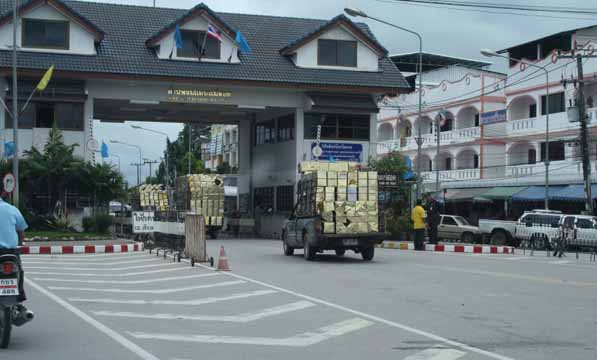Stranded in Midstream

Once again, the flow of goods across the Moei River between Burma and Thailand has been brought to a standstill by bilateral bickering and Burma’s internal tensions
Anyone looking for clues as to why Burma lags so far behind its Southeast Asian neighbors in terms of economic development need look no further than the Friendship Bridge spanning the Moei River between Myawaddy, Burma, and Mae Sot, Thailand.
 |
| Japanese motorbikes are loaded onto a truck in Mae Sot to be transported across the border to Burma. (Photo: Moe Kyaw / The Irrawaddy) |
Since its construction in 1997, the bridge that links Mae Sot and Myawaddy has served more as a barometer of tensions between the two countries than as an enduring symbol of their supposed friendship. But frequent closures—usually at the instigation of Burma’s military regime—signify more than just the usual friction between nations: They are also a symptom of the junta’s disdain for the sort of small-time business activity that sustains most ordinary Burmese.
Since the bridge and other border crossings in the area were closed on July 18, local businesses have lost an estimated US $2.7 million in trade per day, according to Thai officials. As far away as Rangoon, prices of consumer goods have risen dramatically due to this latest trade blockade. But as the dispute—ostensibly over Thailand’s construction of a concrete embankment on its side of the river—drags on, the generals in Naypyidaw remain stolidly noncommittal about when they will allow the border to reopen.
Things don’t always get this out of hand. Under normal circumstances, border issues are handled on the Burmese side by the Office of the Commander in Chief (Army), which in 2007 gave a green light to Thai plans to carry out maintenance work on the Friendship Bridge on the Moei River. In the same year, however, it instructed the Ministry of Foreign Affairs to formally protest Thailand’s construction of a fence around border gate BP-1 between Pungpahkyem in Mongton Township, Shan State, and Fang District in northern Thailand. And there the matter ended.
In the current dispute, however, the disagreement quickly escalated because the subject of the embankment at the Brigade Gate, located a few kilometers north of the Friendship Bridge, came up at the Burmese junta’s triannual meeting of regional commanders, according to official sources in Naypyidaw. The order to shut the border came directly from top generals, including junta supremo Snr-Gen Than Shwe, the sources said.
But the regime’s irritation at its neighbor is only part of the problem. An embankment now being built on the Burmese side—paid for by Thailand as compensation for damage supposedly caused by construction changes made on its side of the river—could ease bilateral tensions, but other issues could still stand in the way of a return to normal trade.
It is notable that the Brigade Gate is the main point of entry into Burma for unregistered used vehicles from Japan. It was also, until recently, under the control of the Democratic Karen Buddhist Army (DKBA), an ethnic cease-fire group that derives most of its revenue from border trade. But the dispute with Thailand has given the regime a pretext to send troops to the gate, effectively enabling it to reassert control over the lucrative used-car trade and increase pressure on the DKBA to become a border guard force (BGF) under Burmese command.
In its dealings with the Thais, the Burmese side has intimated that the current dispute is about more than just a disagreement over the embankment.
1 | 2 next page »
